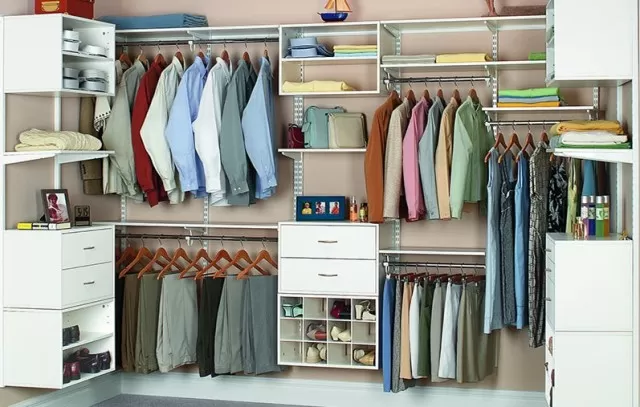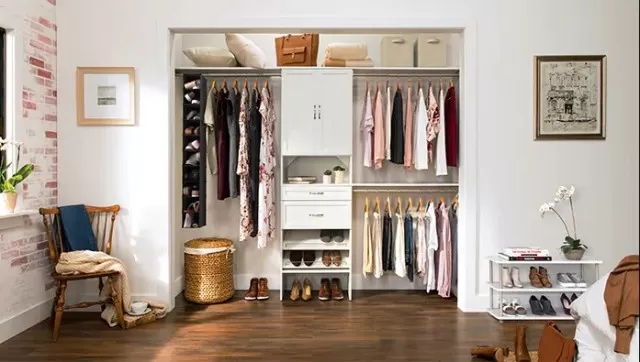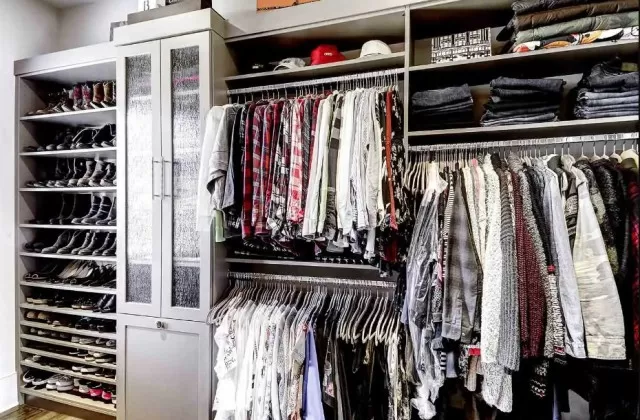Organizing a small closet can be a challenge, especially when you want to give your favorite blouses and sweaters the space they deserve.
Organizing a small closet can be a challenge, especially when you want to give your favorite blouses and sweaters the space they deserve.
However, there are various strategies you can employ to create more room or optimize the existing space in your closet. Whether your closet is small or large, and regardless of the size of your clothing collection, these practical storage ideas will assist you in maximizing your closet’s potential.
With these clever tips, you’ll learn folding techniques and innovative sweater storage ideas that will enable you to make the most of your small closet.
By implementing these strategies, you’ll discover that maximizing storage space is an achievable goal, regardless of the limitations of your closet’s size.
13 Methods to Maximize Closet

Streamline Your Wardrobe.
Begin by tackling the most obvious way to create more space in your closet: decluttering your clothes.
Dedicate a few hours to pull everything out, categorize them, and make decisions. Set aside items you no longer wear for donation and seek a friend’s input for items you’re unsure about.
If you haven’t worn something in over a year, it’s likely you won’t wear it enough in the future to justify keeping it in your closet. Consider storing special occasion items elsewhere, like a Guest Room closet with extra space.
Take the time to go through every item, including belts, bags, and hats, ensuring that everything you put back into the closet is something you genuinely love.
Embrace Containment.
Apart from shoes and handbags, everything else on the closet shelves should be contained to maximize the space.
File-fold sweatpants and shirts into matching bins and label them accordingly. Place clutches and belts in separate bins to keep them organized.
Keeping loose items together in one place rather than scattered on shelves or the floor helps maintain organization. Opt for baskets and bins that won’t snag soft materials, avoiding wicker, metal, or rattan options.
Install Additional Shelves.
If you have available space, consider installing shelves in underutilized areas of your closet.
Adding a single shelf above the hanging rod or a slim, vertical shelf in a corner maximizes storage capacity. Folding bulkier items like sweaters and pants on shelves instead of hanging them saves space and provides better visibility.
Keep a foldable step stool nearby if you opt for taller shelves to ensure easy access.
Invest in a Customizable Closet System.
To make the most of your Closet Space, consider investing in a customizable closet system.
Many companies offer to-measure services to design a system tailored to your closet’s square footage and contents. They can ensure that there’s enough room for longer items, providing appropriate hanging space.
Prioritize knowing what you have and decluttering items you no longer want to work with accurate measurements. Closet systems have the advantage of adjustability, allowing you to adapt them as your storage needs and lifestyle change.
While the cost may range from a few hundred to a few thousand dollars depending on size, materials, and installation, the investment is worthwhile if it fits within your budget.

Utilize Corner Space.
If your closet has an unused corner, consider incorporating corner shelving to optimize storage.
These shelves typically come in metal, wire, or wood finishes to match your existing aesthetic. Depending on the size of the shelves, you can store two pairs of shoes per shelf by placing one on each side of the corner, creating an efficient shoe storage solution.
Choose Space-Saving Hangers.
With reasonably priced slimline hangers available in the market, it’s recommended to replace old, bulky hangers.
Thick hangers, even the plastic tubular ones, take up unnecessary space and hinder optimal hanging storage. Switching to slimline hangers frees up additional room on the rod, even without decluttering.
For those with limited space, consider space-saving hangers like cascading pant clip hangers that allow you to store multiple items in a single straight line.
Master the Art of File Folding.
File folding, popularized by Marie Kondo, is an effective technique to maximize closet space.
Folding your clothes using this method saves considerable space and allows for easy visibility of your entire wardrobe at a glance. If your closet has drawers or bins, ensure that clothing is folded vertically for easy access.
Adding spring-loaded drawer dividers helps maintain a tidy arrangement.
Optimize with Stacked Bins.
Utilize stacked open-front bins when you have sufficient vertical space and don’t want to add extra shelves.
They provide a simple solution for busy mornings, allowing you to quickly retrieve items. Stacked bins are also useful for organizing clothes by season, facilitating easy swapping.
For example, the bottom bin can store heavy winter sweaters, while the one above can hold lighter sweaters for the rest of the year. Similarly, stackable drop-front shoe boxes are convenient, as you can grab a pair without disturbing the entire stack.
Utilize the Back of the Closet Door.
If you have a standard closet door, consider using a customizable rack organizer.
Baskets can hold small purses and fabric care items like lint rollers and shoe repair kits, while hooks on a pegboard can accommodate cross-body bags, scarves, or hats. If your closet has bifold or sliding doors, this method may not work, but racks designed for wall mounting can be an alternative if you have available slim wall space within the closet.

Alternate Shoe Directions.
To save space when storing shoes on a shelf, alternate their direction.
Instead of having all toes and heels facing the same way, leave the right shoe in its original position and turn the left shoe around. This simple adjustment can gain a few extra inches on each shelf or rack, allowing you to fit in an additional pair or two of shoes.
Utilize Under-the-Bed Storage.
If you’ve maximized your closet’s potential and still need more space, think outside the box and consider under-the-bed storage options.
Utilize under-the-bed storage boxes with lids to store off-season clothes like bathing suits and sundresses during colder months, as well as bulky sweaters during the summer.
Add a Double Hang Rod or Hanging Sweater Cubby.
Double hang rods provide an adjustable and cost-effective solution to increase hanging space.
By placing hooks on either side of a short section of clothing, such as shirts, you can create space below for hanging another category, like shorts. This instantly doubles the amount of hanging space while ensuring visibility.
If a double hang rod isn’t feasible, consider using a hanging sweater cubby. Although designed for sweaters, they can be used to store jeans, scarves, hats, clutches, and more, utilizing minimal hanging space.
Drawer inserts can be added to better organize smaller items and minimize visual clutter.
Consider a Garment Rack.
For additional storage space outside of the closet, consider placing a wardrobe or garment rack in the bedroom, guest room, or laundry room.
It can be an open storage solution or have doors to keep items hidden. Open shelving units provide an opportunity to showcase prized items, creating a boutique-like display.
*The information is for reference only.